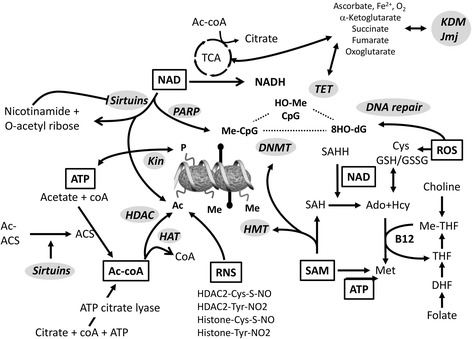Figure 1.

Metabolic pathways generate essential metabolites for chromatin- and DNA-modifying enzymes. NAD, acetyl-coenzyme A (Acetyl-coA), and S-adenosylmethionine (SAM) are elemental for epigenetic control of transcription including methylation of DNA and posttranslational modifications of histones and non-histone chromatin factors (not shown). NAD contributes to transcriptional control mainly via the activity of the protein deacetylase sirtuin, which uses NAD as one of the substrates. Sirtuins are also important for maintaining the activity of the acetyl-coA acetyltransferases. Acetyl-coA is synthesized by acetyl-coA-synthetase (ACS) and ATP-citrate lyase that use acetate and citrate as the precursors, respectively. Citrate is an intermediate/product of the TCA cycle. SAM is the methyl donor for DNA, RNA, histones, and non-histone protein methylation. S-adenosylhomocysteine (SAH) generated in each round of methylation reaction is a potent inhibitor of methyltransferases and has to be cleared by SAH hydrolase (SAHH). NAD is an essential coenzyme for SAHH. Synthesis of methionine from homocystein is achieved through extracting the methyl group from betaine, derived from choline, or 5-methyl-THF, a derivative of folic acid. Metabolism of phospholipids and folic acid may thus indirectly contribute to epigenetic regulation. Likewise, the abundance of NAD and citrate is linked to the cellular energy flux, e.g., the TCA cycle. Changes in the expression of certain genes may therefore be influenced significantly. Abbreviations used: Acetyl-coA, acetyl-coenzyme A; ACS, acetyl-coA-synthetase; AC-ACS acetylated-ACS; Ado, adenosine; HAT, histone acetyltransferase; Hcy homocysteine; MTases, methyltransferases; NAD, Nicotinamide adenine dinucleotide; ROS, reactive oxygen species, RNS, reactive nitrogen species, SAH, S-adenosyl homocysteine; TCA, tricarboxylic cycle; THF, tetrahydrofolate.
